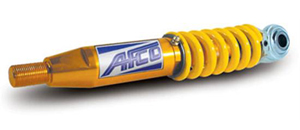Order a Free Catalog
Click Here to request one of Speedway's FREE catalogs!
Here to Help You
To reach our knowledgeable reps:
Call: 800.979.0122 800.979.0122
Order Line (CST)
7am - 10pm - Every Day!
Race and Rod Tech Support
M-Fri 8am - 5pm
Customer Service
M-Fri 8am - 5pm
International Customers Call
Speedway Motors is America’s Oldest Speed Shop® and has been a trusted source for high performance parts for street rods and racing for over 74 years. Speedway Motors has built a reputation for providing friendly expert advice and superior service. Whether you are racing, building a street rod or restoring an old classic, Speedway Motors has the performance parts you need – in stock and ready to ship today.

Ultimate Guide to Spring Rod Suspensions
By Speedway Motors
Created 2014

This innovative component is used on cars with linkage type suspensions. Cars with 2-point, 3-point, 4-link, or other linkage rears can use this part to promote rear axle steer during acceleration. A spring rod can be used on the left and/or right rear suspension as a trailing arm on both dirt and pavement racecars. It allows the associated tire to move forward during acceleration. Left side mountings promote loose roll steer, whereas right side mountings promote tight roll steer.
Adjustment
- Spring rods do not promote bite - they react to bite and control what traction is available in a way that helps the car get off the corner quicker
- Since this is accomplished by controlling rear end steer tendencies under acceleration, then any adjustment will be in response to what the car is doing
- If the car is pushing off the corner, adjust steer by:
- Increasing spring preload (RR)
- Reducing spring preload (LR)
- If the car is loose off the corner, adjust steer by:
- Reducing spring preload (RR)
- Increasing spring preload (LR)
- The amount of adjustment depends on track conditions and experience
- Generally, when the car is close, an 1/8" adjustment (1-1/2 turns) can be felt
- As a general rule, the most movement you’ll ever be able to use is 1-1/2" with an average between 1/2" and 1"
- Be sure to check side clearance on torque arm to ensure that at the maximum wheelbase change there is no interference with driveshaft
Maintenance
- If the sliding parts are aluminum they are subject to wear in abrasive conditions
- Generally, complete rebuild instructions are included with each spring rod
- Most spring rods are shipped with a wrench kit to perform all necessary adjustments
Ordering Information
- Center-to-center length of the spring rod should be set the same as the solid radius rod would be in same location
- Initial preload on spring should be set at 4" loaded length of spring (free length is 4-1/2")
- Spring selection is based on the following conditions:
- Greasy, slick track or dry, dusty track generally requires a lighter spring rate, regardless of tire and body rules (650#)
- Extra-light cars (such as Sprint Cars, Modifieds or Late Models under 2000#) generally use lighter rate spring (650#)
- Tracks with good bite, medium to heavy cars, all asphalt applications use heavy springs (900# to 1050# Dirt and 1200#, 1600#, or 2000# Asphalt)
Quick Tip
When racing on a dry, slick dirt track, the car can turn into the corner better if the right rear suspension is trailed. Use a spring rod to let the tire move forward under acceleration. This can also save the right rear tire in long races.
Spring Rod Exploded View
